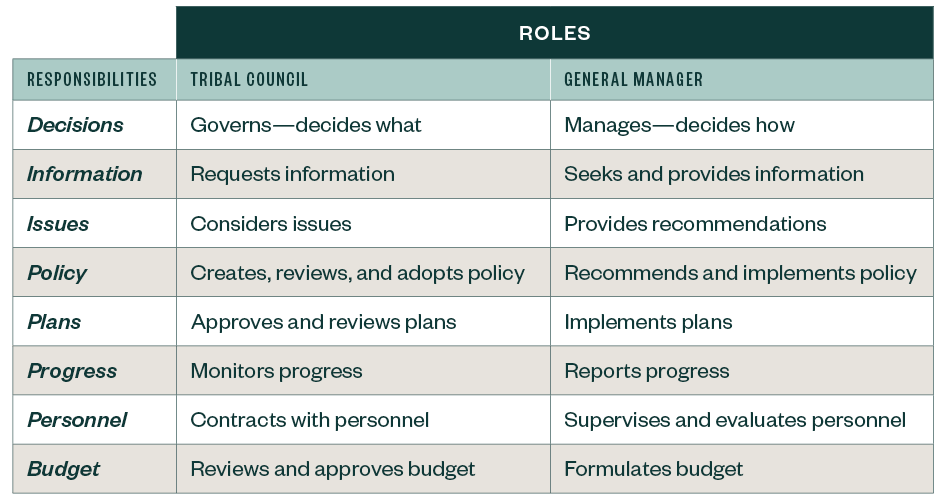
Your Tribal government’s budget is its most important tool for strategic planning and policy implementation. However, it can be challenging to create budgets that are timely, effective, and understood by Tribal Council, management, staff, and members.
Implementing four key budgeting best practices can help bolster your Tribal government—serving as an effective tool for operations, leadership, and accountability.
1. Review Ordinances, Policies, and Procedures
Chances are, your Tribe’s budget ordinance, policies, and procedures haven’t been updated in some time.
Budget Ordinances
It’s a best practice for the Tribal Council to review the Tribe’s ordinance every three-to-five years and verify it aligns with current operations and budgeting best practices.
Most Tribal governments’ budget ordinances outline the following:
- Authority and roles of the Tribal Council, audit and finance committees, and general manager
- Fiscal-year schedule and budget-completion date
- Opportunity for community input
- Draft-budget review processes
- The Tribal Council’s consideration of the budget
- Budget adoption date and approach
- Expenditure authority
- Reporting requirements
- Budget adjustment thresholds
To be most effective, your budget ordinance should provide a framework for budget development and monitoring and allow for appropriate Tribal Council involvement.
Policies and Procedures
Once your Tribe’s ordinance has been updated, it’s time to revisit your policies and procedures.
Policies and procedures are easier to revise over time to better reflect operational changes. At a minimum, your Tribe should have policies and procedures that cover:
- Budget development, monitoring, and reporting
- Common financial decision-making situations—for example, contingency funds, debt management, investments, grants, and reserves
2. Connect Your Budget and Strategic Plan
Effective budgets are clearly tied to strategic objectives, and they allocate resources according to priorities.
Outcome-Based Budgeting
Your Tribe can connect its budget and strategic plan by applying outcome-based budgeting. This approach can elevate your Tribe’s budget from a hypothetical plan to a proposal that clarifies goals and helps achieve results.
For example, if you budget in terms of outcomes, you’ll likely see where your investments are making an impact. You’ll then be able to show membership where expenditures are going, allowing you to better plan for the future.

Cross-Department Collaboration
As your Tribe is developing its budget, different departments and programs should create annual operating plans. These plans should lay out how goals established in the strategic plan and budget will be achieved. The operating plans can be included in the budget document, which then becomes a comprehensive annual roadmap for Tribal Council, leadership, and staff.
Performance Measures
Performance measures are a key component of accountability to your membership and Tribal Council, and they should be part of an outcome-based budget. Establishing a manageable set of performance measures that are tied to the outcomes you hope to achieve can help:
- Align definitions of success across the Tribe
- Encourage dialogue about progress toward goals
- Facilitate timely identification of successes and challenges
- Ground decisions in concrete data and evidence
- Illuminate relationships between different activities
- Clearly show performance against defined targets over time
3. Engage Your Tribal Council
Tribal budgeting can be complex and have many revenue streams and reporting requirements. In addition, elected officials regularly cycle on and off Tribal Council, requiring staff to frequently educate council members on the budget and their role in determining the Tribe’s financial policies and strategies. Having a clear understanding of roles and responsibilities can create a smoother budget process.

During budget formulation and review, Tribal Council members should ask the following questions:
- Are there specific financial objectives we want for next year?
- Are there desirable new projects, program expansions, or changes in compensation?
- Are there large expenses for which we should be saving?
- Should we consider revisiting how we use our unrestricted funds?
- Is our dollar allocation generally in line with our priorities?
4. Engage Membership
Many Tribal governments engage their membership in the budget process through public hearings or open houses. This practice helps to better align the budget with priorities, reveal community needs, and build trust and accountability.
When presenting the budget to membership, the conversation should focus on:
- Programs and services
- Performance measures
- Budgetary allocations and relevant changes
- Future plans
Tribal leadership should engage membership and discuss priorities, plans, and how resource allocation supports Tribal objectives. Leadership should also provide membership with a mechanism to help their priorities, needs, and ideas be heard and understood.
We’re Here to Help
Your Tribe’s budget should be based on your particular needs, goals, and circumstances. To learn more about how your Tribe can build and implement an effective budget, contact your Moss Adams professional.